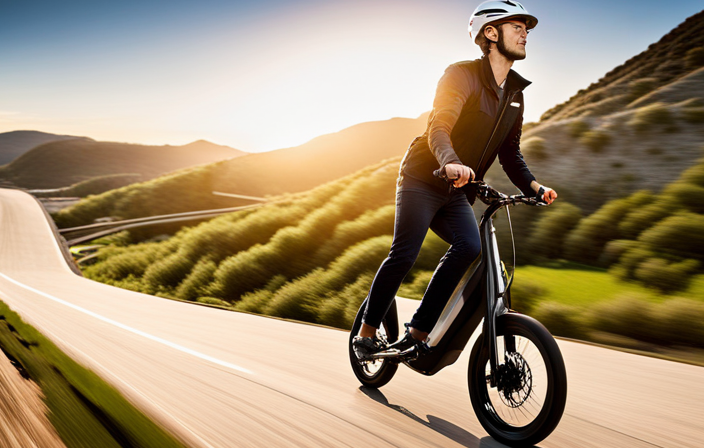Have you ever felt the wind against your face as you effortlessly glide through the streets on a bike? It’s a feeling of freedom and exhilaration that is hard to match.
Now, imagine experiencing that same joy while also reducing your carbon footprint and improving your health. This is the power of electric bikes.
In this article, we will explore the many benefits of electric bikes, from their technological advancements to their environmental impact, health benefits, and cost efficiency.
Get ready to discover just how good electric bikes can be.
Key Takeaways
- Regular maintenance is important for optimal performance and safety of electric bikes.
- Electric bikes are accessible and safe for riders of all experience levels, with features that make them beginner-friendly.
- When choosing an electric bike, consider factors such as range, motor power, frame type, and maintenance requirements.
- Taking good care of your electric bike, including regular cleaning and proper battery charging, can ensure its longevity and maximize performance.
Understanding Electric Bike Technology
Electric bikes are a great alternative to traditional bicycles because they offer the convenience of motor assistance. This technology has come a long way in recent years, making electric bikes more popular than ever.
One of the key advantages of electric bikes is their low maintenance requirements. Unlike cars, electric bikes don’t need regular oil changes or complicated engine repairs. They also have fewer moving parts, which means less wear and tear.
Another advantage of electric bikes over cars is their environmental impact. Electric bikes produce zero emissions, helping to reduce air pollution and combat climate change. Plus, they are much more energy-efficient than cars, making them a greener transportation option.
Overall, electric bikes are a smart choice for those looking for a convenient, low-maintenance, and eco-friendly mode of transportation.
Comparing Electric Bikes to Traditional Bicycles
Comparing e-bikes to traditional bicycles, they offer a more efficient and effortless mode of transportation. Electric bikes require less physical effort from the rider, making it easier to travel longer distances and tackle hilly terrains. With the assistance of a motor, riders can reach higher speeds with less exertion. Moreover, electric bikes have shown to be a viable alternative to cars for short commutes, reducing traffic congestion and carbon emissions.
In terms of maintenance, electric bikes do require some upkeep. Regular battery charging and occasional motor maintenance are necessary to ensure optimal performance. However, compared to the maintenance needs of traditional bicycles, electric bikes are relatively low-maintenance. Additionally, advancements in electric bike technology have led to improved battery life and more efficient motors, enhancing their overall performance.
Overall, electric bikes provide a convenient and eco-friendly option for transportation. Their efficiency and ease of use make them a practical choice for commuters and recreational riders alike.
Assessing the Environmental Impact of Electric Bikes
When assessing the environmental impact of e-bikes, it is important to consider their carbon footprint and contribution to sustainable transportation options.
Electric bikes have several positive environmental attributes that make them an appealing choice for urban mobility:
-
Reduced emissions: Electric bikes produce zero tailpipe emissions, reducing air pollution and improving air quality in urban areas.
-
Energy efficiency: Compared to traditional cars, electric bikes are much more energy-efficient, requiring only a fraction of the energy to travel the same distance.
-
Noise pollution reduction: Electric bikes operate quietly, minimizing noise pollution and creating a more peaceful urban environment.
-
Congestion reduction: With their ability to navigate traffic and access narrow spaces, electric bikes can help reduce traffic congestion, making cities more efficient and less stressful.
These factors, combined with proper electric bike regulations, can contribute to a more sustainable and environmentally-friendly urban transportation system.
Exploring the Health Benefits of Electric Biking
Exploring the health benefits of e-biking can lead to improved physical fitness and cardiovascular health. Electric biking provides an excellent form of physical activity that can benefit individuals of all fitness levels. Engaging in regular e-biking can help improve muscle strength, endurance, and flexibility. It also promotes weight loss and helps control body weight, reducing the risk of obesity-related diseases. Additionally, e-biking is a low-impact exercise, which means it puts less stress on joints compared to other forms of physical activity such as running or jogging.
To further illustrate the health benefits of electric biking, consider the following table:
| Health Benefits of E-Biking |
|---|
| Improved cardiovascular health |
| Increased muscle strength and endurance |
| Weight loss and weight management |
| Low-impact exercise for joint health |
| Enhanced flexibility and mobility |
It is clear that e-biking offers numerous health benefits, making it an excellent choice for those looking to improve their physical fitness and overall well-being.
Evaluating the Cost Efficiency of Electric Bikes
Evaluating the cost efficiency of e-bikes can help individuals make informed decisions about their transportation options. When considering the cost effectiveness of electric bikes, there are several factors to take into account.
Here are three key points to consider:
-
Initial Investment: While electric bikes may have a higher upfront cost compared to traditional bicycles, they can save money in the long run by eliminating the need for fuel and reducing maintenance expenses.
-
Fuel Savings: Electric bikes offer a more affordable alternative to cars and motorcycles. With no need for gas, the cost of commuting can be significantly reduced, leading to long-term savings.
-
Maintenance Costs: Electric bikes have fewer moving parts compared to cars, making them less prone to breakdowns and costly repairs. Regular maintenance, such as battery replacement, is generally less expensive than traditional vehicle maintenance.
By considering these factors, individuals can evaluate the cost efficiency of electric bikes and make a decision that is both financially and environmentally conscious, ensuring long-term savings and a sustainable mode of transportation.
Considering the Range and Battery Life of Electric Bikes
To make an informed decision, you should take into consideration the range and battery life of an e-bike.
When it comes to electric bikes, the range refers to the distance you can travel before the battery needs to be recharged. This is an important factor to consider, especially if you plan on using your e-bike for long commutes or extended rides.
Additionally, battery life is crucial as it determines how long the battery will last before it needs to be replaced. It’s worth noting that the range and battery life of an electric bike can vary depending on factors such as terrain, rider weight, and speed.
When considering an e-bike, it’s also important to look at battery charging options and maintenance requirements. Some e-bikes offer removable batteries that can be charged separately, while others require the entire bike to be plugged in.
As for maintenance, regular battery check-ups and proper storage can prolong its lifespan.
Overall, understanding the range and battery life of an e-bike is essential for a smooth and enjoyable riding experience.
Examining the Safety Features of Electric Bikes
When it comes to ensuring your safety while riding, it’s important to examine the various safety features available on e-bikes. Electric bikes are equipped with several safety features that contribute to a safer riding experience.
Here are three sub-lists discussing these safety features:
-
Lighting and visibility: Many electric bikes come with integrated lights, including headlights and taillights, to enhance visibility. This is crucial, especially when riding at night or in low-light conditions. Some electric bikes even have additional safety features like brake lights and turn signals.
-
Braking system: Electric bikes typically have advanced braking systems, such as hydraulic disc brakes, that provide reliable stopping power. These brakes are designed to be responsive and effective, ensuring quick and safe stops.
-
Speed control: Some electric bikes have speed limiters or pedal-assist modes that allow riders to control their speed. This helps ensure that the bike’s speed remains within legal limits, promoting safety and compliance with electric bike regulations.
To maintain safety, it’s important to regularly maintain your electric bike. This includes checking the battery, tires, brakes, and overall bike condition. Following the manufacturer’s maintenance guidelines will help ensure optimal performance and minimize risks while riding.
By adhering to electric bike regulations and practicing proper maintenance, riders can enjoy a safer and more enjoyable riding experience.
Addressing Common Misconceptions about Electric Bikes
One common misconception about e-bikes is that they are only suitable for experienced riders. However, this is far from the truth. E-bikes are designed to be accessible and user-friendly for riders of all experience levels.
In fact, many e-bikes come with various safety features that make them even more suitable for beginners. For instance, most e-bikes have pedal-assist modes that provide an extra boost when pedaling, making it easier to navigate hills and ride longer distances. Additionally, e-bikes often have adjustable power settings, allowing riders to start at a lower level of assistance and gradually increase as they gain confidence and experience.
Furthermore, studies have shown that e-bikes can actually improve safety on the roads, as they encourage more people to cycle and reduce car usage.
So, it’s important to debunk these misconceptions and recognize the benefits and accessibility of e-bikes for all riders.
Tips for Choosing the Right Electric Bike for Your Needs
Consider your specific needs and preferences when selecting the perfect e-bike for you. There are a few key factors to keep in mind when choosing an electric bike.
-
Range: Look for a bike with a battery that can provide the range you need for your daily commute or recreational rides. Consider factors such as terrain and weight when determining the range you require.
-
Motor Power: The power of the motor will affect the bike’s performance. If you plan on tackling hilly terrain, a more powerful motor may be necessary.
-
Frame Type: Choose a frame type that suits your riding style and comfort preferences. Options include step-through, mountain, and folding frames.
Additionally, it’s important to think about electric bike maintenance. Regularly check and clean your bike, ensuring the battery is properly charged and the tires are inflated. Follow the manufacturer’s guidelines for maintenance and consider getting your bike serviced annually.
By taking good care of your electric bike, you can ensure its longevity and maximize its performance.
Real-Life Experiences and Testimonials with Electric Bikes
To truly understand the benefits of an e-bike, you have to hear the real-life experiences and testimonials from those who have already embraced this mode of transportation. People from all walks of life have shared their stories and it’s clear that electric bikes offer a range of advantages. One of the most common benefits mentioned is the ease of commuting, especially in busy cities where traffic congestion is a daily struggle. Users have also praised the ability to cover longer distances without getting exhausted, thanks to the electric assistance. Additionally, e-bikes have been praised for their positive impact on the environment, as they produce zero emissions and reduce the reliance on fossil fuels. However, it’s important to note that some users have reported drawbacks such as high initial costs and limited battery life. Overall, real-life experiences with electric bikes highlight their numerous benefits, but it’s essential to consider individual needs and circumstances before making a purchase.
| Benefits | Drawbacks |
|---|---|
| Easy commuting in busy cities | High initial costs |
| Ability to cover longer distances | Limited battery life |
| Positive impact on the environment |
Frequently Asked Questions
Are electric bikes as fast as traditional bicycles?
Electric bikes can reach speeds comparable to traditional bicycles, depending on various factors. Efficiency-wise, electric bikes excel in hilly terrains due to their electric motor assistance, while traditional bikes may require more physical effort.
Can electric bikes be used in hilly areas?
Electric bikes can be used in hilly areas due to their long electric bike battery life and advantages. They provide assistance when riding uphill, making the journey easier and more enjoyable. This eco-friendly mode of transportation is a great option for hilly terrains.
How long does it take to charge the battery of an electric bike?
Charging time for an electric bike varies based on battery capacity. On average, it takes around 4-6 hours to fully charge. However, higher capacity batteries may take longer. It’s important to consider charging time when planning rides.
Are electric bikes suitable for long-distance commuting?
Electric bikes are suitable for long-distance commuting. They require minimal maintenance, and the cost of operating them is significantly lower compared to traditional bicycles. Additionally, they are an environmentally-friendly mode of transportation.
Do electric bikes require a license or registration to use on public roads?
Electric bikes do not require a license or registration to use on public roads. Safety regulations vary by location. As electric bike popularity grows, traditional bicycle sales may be impacted, but environmental benefits outweigh any concerns.
Conclusion
In conclusion, the electric bike proves to be a remarkable mode of transportation, blending innovative technology with traditional cycling.
By carefully considering its environmental impact, health benefits, and cost efficiency, it becomes evident that this eco-friendly option offers a practical and sustainable solution.
Furthermore, the safety features embedded in electric bikes ensure a secure and enjoyable ride. Addressing common misconceptions, these bikes are a viable choice for individuals seeking a reliable and efficient means of transportation.
Real-life experiences and testimonials only solidify the undeniable advantages of embracing electric biking.









